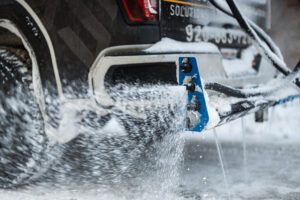When winter hits Berks County, PA, municipalities, contractors, and fleet operators need to make cost-effective decisions about snow removal. One of the biggest questions that we hear every year is, “Is liquid deicing better than salt?” The short answer is, it depends on your goals. But understanding the pros and cons of both options can help you invest in the right equipment and snowplow accessories for your operations. Here is everything you need to know about liquid deicing versus traditional salt, and which might be better for you.
The Power of Liquid Deicing
Liquid deicing is becoming increasingly popular, especially in areas like Berks County where early treatment and road safety are top concerns. It can be used as a pre-treatment (anti-icing) before the snow falls or a post-treatment to break up ice after accumulation.
Pros:
- Reduces the amount of salt needed by up to 70% on post-treatment and 35% on pretreatment applications.
- Works for you immediately, getting to bare pavement quicker and reducing your labor costs.
- Causes less surface damage, increasing the life span of yours and your clients’ roadways and sidewalks.
- No leftover residue which means product is not being tracked into buildings, reducing janitorial costs.
- It is better for the environment.
Cons:
- Higher upfront equipment costs for tanks, sprayers or calibration equipment.
- Can require more planning and weather monitoring.
- May be less effective in extreme cold without additives.

The Case for Traditional Road Salt
Rock salt has been the go-to solution for decades. It is a familiar and cost-effective solution that is easily applied using standard spreaders.
Pros:
- Readily available and affordable.
- Easy to apply with existing salt spreaders.
- Effective down to about 15°F.
- Has a long shelf life so it can be stored and used over time.
Cons:
- Requires heavy application for maximum effectiveness.
- Can bounce off the road when being applied, which can reduce efficiency.
- Can be more harmful to vehicles, infrastructure and the environment.
- Is known to act slower compared to liquid options.
If you are running older snow removal truck equipment, you likely already have spreaders and storage solutions in place for rock salt, but that does not necessarily mean that it is the right choice for you moving forward.
Our Recommendation for Berks County Fleets
The best approach? A hybrid method. You do not have to limit yourself to using only one kind of deicing product. It pays to have several different kinds in your arsenal, and combining them can maximize their efficacy. Prewetting, or mixing liquid deicer into rock salt before spreading it can be a useful tactic, particularly when working with pre-existing ice at very low temperatures.
Whether you are choosing liquid deicing or rock salt, Levan Machine and Truck Equipment is here to make sure you have the right tools to get the job done. Contact our team today to learn more about how we can help you get through the cold months ahead.
